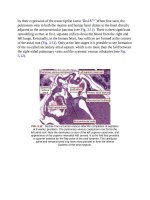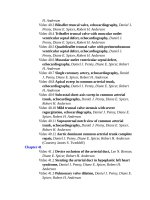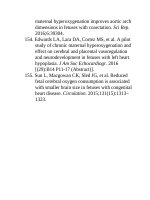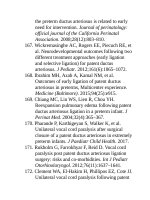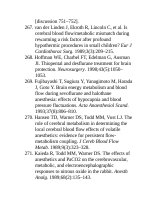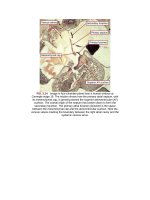Andersons pediatric cardiology 1853
Bạn đang xem bản rút gọn của tài liệu. Xem và tải ngay bản đầy đủ của tài liệu tại đây (85.41 KB, 3 trang )
postoperativeneonatesandemploysaprobethatemitsanear-infraredspectrum
oflightthatisplacedontheforeheadandmeasuresvenousoxygensaturations.
Lowcerebraloxygensaturationsinthe48-hourperiodfollowingtheNorwood
operationhavebeenassociatedwithbrainMRIabnormalitiesandpoor
neurodevelopmentaloutcomes.133,134Itisnotcleariflowsaturationsarethe
causeofbraininjuryoramarkerforinfantswithreducedphysiologicreserve.
CentersthatroutinelyuseNIRStargetinterventionstokeepcerebralNIRS
saturationsgreaterthan50%;thesemeasuresincludesedation,mechanical
ventilation,paralysis,packedredbloodcelltransfusion,andinotropicsupport.A
largelimitationofNIRSisthatithaspoorreproducibilityandpoorintersubject
reliability,whichhavelimitedrecommendationsforitsroutineuse.135
ContinuousElectroencephalography.
Postoperativeseizureshavebeendetectedinone-quartertoone-thirdofneonates
withhypoplasticleftheartsyndromeundergoingsurgerywithcardiopulmonary
bypass.136Seizuresarelargelysubclinicalandhavebeenassociatedwith
mortalityandneurodevelopmentaldysfunction.136–138Routinepostoperative
continuousEEGmonitoringhasbeenrecommendedbytheAmerican
NeurophysiologySociety;however,thewidespreadimplementationofEEG
monitoringislimitedbytheintenseutilizationofresourcesassociatedwiththis
strategy.139
HeadUltrasonography.
Ultrasonographyoftheheadiswidelyusedtoscreenforpreoperativeand
postoperativebraininjury,althoughtherearefewdatatosupportroutineuse.
Headultrasonographycandetectstructuralabnormalitiesofthebrainandlarge
hemorrhagesandisusedroutinelytomonitorneonatesandinfantson
extracorporealmembraneoxygenation.However,itisinsensitiveforthe
detectionofstrokesandhasahighfalse-positiverateforhemorrhagethatisnot
substantiatedbyMRIofthebrain.140
BrainMagneticResonanceImaging.
ThecurrentgoldstandardimagingmodalityisMRIwithMRangiography
coupledwithdiffusion-weightedimagingandperfusionimaging;these
modalitiesplayacriticalroleinevaluationofthepathophysiologyofbrain
injury.Inthepostoperativeperiodidentifiedriskfactorsincludehypoxemia,
diastolichypotension,cardiopulmonarybypasswithregionalcerebralperfusion,
anddecreasedhemoglobinduringbypass.141,142Dataontheassociationofbrain
MRIabnormalitiesinthispopulationwithlong-termneurodevelopmental
outcomearelimited,butrecentworksuggeststhatperioperativewhitematter
injuryisassociatedwithworsescoresonneurodevelopmentaltestingatages2
and6years.143
Pain,Sedation,andNeurodevelopmentalCare
Paincontrol,appropriatelevelsofsedation,andemphasison
neurodevelopmentalcareareimperativecomponentsofpostoperative
management.Uncontrolledpainhasbeenshowntoadverselyaffectcentral
nervoussystemdevelopmentinprematureinfants;however,themedications
mostfrequentlyutilizedmayhaveadverseconsequencesaswell.The
hemodynamiceffectsofuncontrolledpainanddistressincludetachycardiaand
hypertension,whichmaybeparticularlydeleteriousforfragileinfantswitha
multidistributioncirculation.FortheearlypostoperativeneonatewithafUVH,
increasesinVO2ataperiodwhenDO2maybeborderline,aswellas
fluctuationsinsystemicandpulmonaryvasculartone,mayleadtocardiacarrest.
Endotrachealtubesuctioning,inparticular,resultsinparticularlynoxious
stimulationatapointwhenmyocardialfunctionisatitslowestandsystemicand
pulmonaryvasculartoneareattheirmostlabile.Ideally,analgesicandsedative
medicationswillbetitratedinamannersimilartovasoactiveinfusionstargeting
theminimaleffectivedose.Additionalas-neededdosesmaybeusedpriorto
anticipatedpainfulornoxiousstimulation.Astheneonateprogressesin
recovery,optimizationofnonpharmacologicinterventionsanddevelopmentally
appropriatecarewillcomplement,medicalmanagement,thuslimitingtheneed
forexcessivesedation.ThesepointsaresummarizedinTable71.7.Amore
completereviewofthetopicofneurodevelopmentalcareandnonpharmacologic
interventionshasrecentlybeenpublishedbyLisantiandcolleagues.144
Table71.7
InterventionsforPainandAgitation:RisksandBenefits
Risk
PHARMACOLOGIC
Neuromuscularblockade
Globaldeconditioningandmyopathy(especiallywith
Benefit
DecreasedVO2
steroiduse)
Masksseizureactivity
Benzodiazepines
Cerebralapoptosis
Increasedriskofdelirium
Hypotension
Narcotics
Feedingintolerance(bowelimmobility)
Dependencesyndrome
Respiratorydepression
Nonsteroidalantiinflammatory
Renaldysfunction
drugs
Plateletdysfunction
Reyesyndrome(<6months)
Dexmedetomidine(Precedex) Bradycardia(maylimitCOinneonates)
Tylenol
Hepaticdysfunction
NONPHARMACOLOGIC
Positionandhandling
Holding
Environmentalmanagement
Nonpharmacologiccomfort
Amnesia
Paincontrol
Nonnarcoticpain
control
Sedation
Nonnarcoticpain
control
Containedflexedpositioningwithsecureboundaries,neutralneck
Early(assoonasmedicallysafe)andoften(atleastdaily)
Limitand/orclusternoxiousstimuli
Promotecircadianrhythms;cyclelightanddarkperiods
Reduceexcessivenoise(alarms,staffconversations)
Clusteredcaretoallowperiodofrest
Pacifiers
Oraldextrose
Containmentpositioningduringprocedures
Voice,particularlyparental
FeedingandNutrition
Inmanycenters,patientsremainfluid-restrictedforthefirst24hoursfollowing
surgery;thusnutritionisinitiallyrestrictedtosimpledextroseinfusion.Oncethe
patientestablishesareliablediuresisandfluidgoalsareliberalized,TPNmaybe
initiated.Inthepatientwhoisreceivingamusclerelaxantandmildlycooled,
restingenergyexpenditureisthoughttobe50kcal/kgperdayandthereisa
generalhypermetabolicstate.145–147ThereforeTPNgoalsaimfor70kcal/kgper
daywithaproteingoalof2to3g/kgperday.Specialconsiderationshouldbe
giventotheprescriptionofaminoacidsinpatientswithpostbypassrenal
impairmentorazotemia.Supplementationofzincandothermicronutrientsmay
beimportantinpatientswithdrainingchesttubesandopenskinwounds.
Thereissignificantpracticevariabilityinthetimingandmodeof
postoperativeenteralfeeding.Theinitiationofnasogastricfeedsisoften
deferreduntilthepatienthasreachedastablephysiologicstatewithevidenceof
adequatecardiacoutput.Theclinicianmustalsoconsiderotherfactors,including
vasoactivedrugdosesandnarcoticinfusions,whichmaycontributetoimpaired
splanchnicperfusionanddecreasedgutmotility.Manycentersemployprotocols
fortheinitiationofcontinuoustrophicfeedswithhumanbreastmilk(e.g.,20
